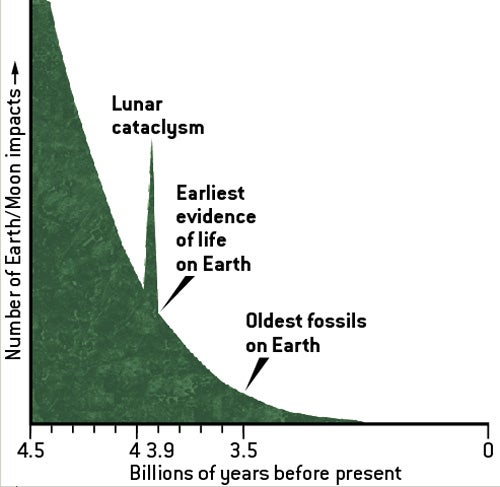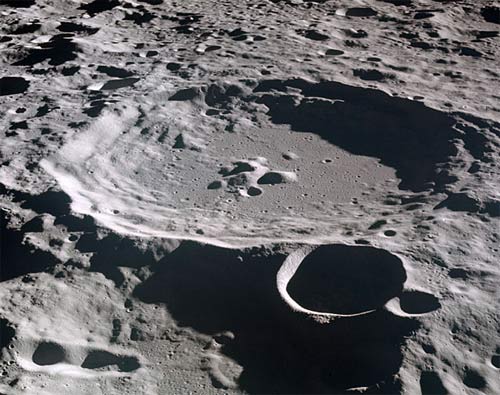The name is brutally descriptive. Late, because it occurred well after the main work of building planets was supposed to be over. Heavy, because no other term fits the arrival of at least 45 large asteroids hitting with titanic force all over the Moon and blasting giant basins within a sliver of geologic time. (Not to mention thousands of somewhat smaller impacts that had less eye-arresting results.) And bombardment, because it left the Moon with a battered, scarred face you can explore with even a small telescope on most clear nights.
The idea of the Late Heavy Bombardment — sometimes called the terminal lunar cataclysm — emerged in the early 1970s from studies of Moon samples brought back by Apollo astronauts. Researchers were unable to find lunar rocks with a date of last melting, or heavy shock, older than about 3.95 billion years.
The samples returned were nearly all breccias, a type of rock consisting of angular fragments welded together by shock; breccias are a common product of meteorite impacts. Within the breccias, some individual fragments had older dates, but they were understood to be lucky survivors — “fossil bits” preserved intact by chance. Thus, scientists concluded some kind of violent, impact-driven upheaval occurred 600 to 700 million years after the Moon formed.
And it’s not just the Moon. If our satellite was struck by a blizzard of asteroids, there’s little chance Earth — or the other terrestrial planets — would have escaped untouched. (This is why scientists have generally abandoned the term “lunar cataclysm” as too specific, and misleading.)
For each impact that blasted out a lunar crater or basin, scientists calculate our planet received about 20 hits similar in size. Mars, Venus, and Mercury would also have seen heavy impacts — the Argyre and Hellas basins on Mars may date from this period, as might the Caloris basin on Mercury.
Like Earth, Venus also displays a geologically young surface. There’s little evidence for plate tectonics there, at least during the last billion years. But the earliest periods of Venus’ history are lost because volcanic activity resurfaced most of Venus within the last 800 million years.
In contrast, the geologically dead Moon preserves a record of its earlier days — and because it’s a lot closer to us than Mercury or Mars, it’s a priceless gift to planetary scientists.
According to researchers studying lunar rock samples, the oldest basin on the Moon’s nearside is Nectaris, dated at 3.92 billion years old. The most recent is Orientale, dated at about 3.8 billion years and visible intermittently, as it lies on the Moon’s western limb. The impacts creating the Humorum, Crisium, Serenitatis, and Imbrium basins occurred in between these two benchmarks.
While dating individual Moon rocks is comparatively easy, dating lunar events is much less so. The difficulty lies in the fact that if you scoop up a rock lying on the surface, there’s little to tell you where that rock was born. A scientist can date events that shocked the rock hard enough to reset its mineralogical clocks — but who’s to say where on the Moon those shocks took place? Most of the lunar surface is a tangled, interwoven mixture of broken and shattered rocks thrown perhaps thousands of miles from their source craters.
As Paul Spudis notes in “The biggest hole in the Moon” (November 2005), this means scientists need a lot more lunar samples from many more places. Moreover, return visits to already sampled sites will let lunar geologists correct their initial views and unravel the real story.
This is why a mission to return samples from the South Pole-Aitken basin received a high priority in a definitive study by the U.S. National Academy of Sciences. Accurate dating of this titanic event will help establish the chronology of the Late Heavy Bombardment.
But what caused the bombardment? Some scientists have questioned its very existence. They say the spike in impact rates around 3.9 billion years ago is a random occurrence, the natural result of having a finite number of big impactors sailing around in Earth’s vicinity. Others argue that because the Imbrium basin impact threw debris over much of the Moon’s nearside, every rock Apollo brought back was essentially sampling that one event.
However, careful study of lunar meteorites — pieces of the Moon that were ejected in impacts and eventually landed on Earth — shows they too have a maximum age of about 4 billion years. Because these meteorites (of which 31 are known) come from random parts of the Moon, they probably don’t share any Imbrium bias and, thus, provide a true picture.
So where did all those big rocks come from? Three studies published in Nature (May 26, 2005) suggest a plausible answer. Rodney Gomes (National Observatory of Brazil), Harold Levison (Southwest Research Institute, United States), Alessandro Morbidelli (Observatoire de la Côte d’Azur, France) and Kleomenis Tsiganis (Observatoire de la Côte d’Azur and University of Thessaloniki, Greece) propose a model that explains the bombardment — and links it to events in the outer solar system.
The researchers suggest the gas-giant planets (Jupiter, Saturn, Uranus, and Neptune) all formed relatively close to each other. These protoplanets were surrounded by countless smaller objects, dubbed planetesimals. Computer simulations by the scientists show the gravity of the growing gas giants scattered the planetesimals, sending some inward and others outward.
When this happened, Jupiter moved slightly closer to the Sun. For its part, Saturn moved outward and found itself in an orbit with precisely twice Jupiter’s period. This orbital resonance, occurring about 700 million years after the solar system formed, caused the orbits of both Jupiter and Saturn to become more elliptical. In response, the orbits of the smaller gas giants, Uranus and Neptune, rapidly became much more elliptical. This unsteadiness had the effect of wildly scattering planetesimals throughout the solar system. These careening bodies also disturbed the rocky asteroid belt, adding to the mayhem.
Flying through the inner solar system, this shower of impactors, rocky and icy, blasted enormous basins on the Moon and the other terrestrial bodies.
“It’s very convincing,” says Levison. “We have made several dozen simulations of this process, and statistically the planets end up on orbits very similar to the ones that we see, with the correct separations, eccentricities and inclinations.”











